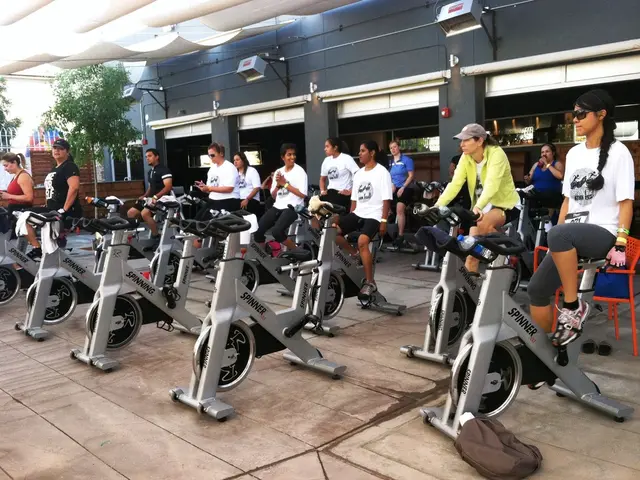Aid for Mobility: Distinguishing Between Walkers and Canes Based on Situation
🚶🏽♂️ Assisting the Aging and Disabled: Canes vs Walkers 🚶🏽♀️
Growing older or living with a disability often brings along mobility issues. Balance and support can become tough, but luckily there are options like canes and walkers that can help maintain independence. Understanding when to use each one and how to make the best choice is crucial.
Walkers and canes provide balance during movement. Canes can offer aid to those with minor weakness in their legs, issues with balance, or those suffering from conditions like arthritis. Walkers, on the other hand, are better for individuals with significant balance impairments or muscle weakness affecting both sides of the body.
A cane is a one-handed device that variable in shape, from a simple single-legged to a three-legged or even a four-legged model known as a "sit-to-stand" cane. They offer more stability for users dealing with discomfort on one side. Plus, there are accessories such as ice grips for icy conditions.
Walkers, on the other hand, are four-legged devices that require the use of both hands and offer increased balance and support. They provide a seat and other features like brakes or a basket to cater to specific needs.
-helps with balance-adjustable
What conditions necessitate a cane or walker?
-for minimal weight bearing only-some have a curved handle that some may find difficult to grasp and cause pain, especially for people with joint or muscle conditions
For those needing only minimal assistance, canes, particularly four-legged versions, are more practical. However, walkers are more suitable for individuals experiencing significant balance and mobility problems. This can include conditions like Parkinson's Disease, Multiple Sclerosis (MS), Stroke Recovery, Osteoarthritis, or Chronic Obstructive Pulmonary Disease (COPD).
-mild balance issues-mild to moderate arthritis of the lower limbs
What types of canes and walkers are available?
$10-$40
Standard canes are usually made of wood or aluminum with a rubber tip and a hook-shaped or flat handle, catering to those needing minimal support. While more robust canes with three or four legs can bear greater weight and offer more stability for users with pain on one side.
Walkers come in three main types: standard walkers with four rubber-tipped legs, two-wheeled walkers for better maneuvering, and four-wheeled rollator walkers for a more natural gait and additional features like brakes, a seat, and a basket.
-offers greater help with balance than a standard cane-can bear more weight-adjustable
Is it better to use a walker or a cane?
-heavier-more cumbersome-may be harder to use on stairs
Effective cane use requires strength and coordination, as individuals must be able to steady themselves if they slip and coordinate the cane with swills. Walkers are more appropriate for those with more significant balance problems because they support more of the body weight and necessitate less coordination.
-one-sided muscle weakness (hemiparesis) or more significant issues with balance
When should one switch from a walker to a cane?
$15-$40
Assessing when to switch from a walker to a cane involves considering whether balance, endurance, or strength have improved or deteriorated, consulting doctors, and evaluating the appropriateness of the daily routine for each device.
Where can one acquire a cane or a walker?
-stable-foldable
Suppliers, clinics or hospitals, insurance providers, and non-profit organizations for older adults or those with disabilities might provide canes or walkers for purchase or rental.
-no wheels-needs lifting with each step
How much does a cane cost vs a walker?
-for conditions that affect the function of muscles or nerves or for fractures
Canes typically cost between $10 and $40, while walkers can vary from $20 to $100.
$20-$60
DME and Medicare
Both canes and walkers are considered Durable Medical Equipment (DME) by Medicare. They can be rented or bought through Medicare Part B if they are deemed necessary for home use and prescribed by a doctor accepting Medicare.
-easier to move-may have a seat and basket for comfort
How do I use a cane or walker safely?
-less stable than standard-not foldable
Regardless of the chosen device, safety should be the priority. Handles should be wrist level, and arms should remain relaxed when using either device. Maintain an upright posture, and never lean forward when walking. Cane and walker safety guidelines should always be followed to avoid accidents and ensure the best use of the device.
-issues affecting the spinal cord, conditions that slow down mobility like heart or lung diseases$35-$100
Mobility issues can arise from certain chronic conditions that develop with age. According to the Centers for Disease Control and Prevention (CDC), older adults experience falls each year, and in older age, falls can lead to serious injuries to muscles and bones. Fortunately, assistive devices like canes and walkers are available to help maintain independence and minimize the risk of falling.

[1] American Family Physician, "Use of Canes and Crutches in the Management of Proximal Hip Fractures," vol. 69, no. 10, 1999, American Academy of Family Physicians.[2] Stanford University School of Medicine, "Walkers, Canes, and Other Aids: The Right Equipment for the Right Job," 2013, Stanford University Medical Center.[3] MedlinePlus, "Assistive Devices," 2021, U.S. National Library of Medicine.[4] Centers for Disease Control and Prevention, "Falls among Older Adults: An Overview," 2021, CDC.gov.[5] Mayo Clinic, "Parkinson's Disease," 2021, MayoFoundation.org.[6] Mayo Clinic, "Multiple Sclerosis (MS)," 2021, MayoFoundation.org.[7] Mayo Clinic, "Stroke Recovery," 2021, MayoFoundation.org.[8] Arthritis Foundation, "Osteoarthritis," 2021, Arthritis.org.[9] American Lung Association, "Chronic Obstructive Pulmonary Disease (COPD)," 2021, Lung.org.
Learn more: What types of mobility aids are available?Is it better to use a walker or cane?Medicare and walkersMedicare and canesHow do I use a cane versus a walker safely?
- Senior health and health-and-wellness are essential focus areas for others, as mobility issues due to aging or disability can greatly impact quality of life.
- Uncategorized, while walking aids like canes and walkers can enable individuals to decrease their reliance on others and maintain independence, they may face drawbacks like cost and potential challenges with specific medical conditions like chronic diseases or age-related factors such as cbd or sports-related injuries.
- Access to credit lines or assistance programs could be essential for acquiring walkers or canes, as the cost for these mobility aids may not be covered under medical insurance or may have high out-of-pocket expenses.
- Fitness and exercise, therapies and treatments, and proper nutrition all play a significant part in managing chronic diseases and prolonging healthy aging, which can in turn decrease the need for mobility aids like walkers or canes.
- Science and medical research continue to explore new solutions, technologies, and alternative treatments for chronic-diseases, aging, and mobility issues, possibly leading to innovations in assistive devices such as canes and walkers.
- Considering the type of mobility aid required is crucial, with walkers generally more suitable for those with significant balance and mobility problems, while canes may be sufficient for those with milder conditions.
- Understanding the unique features and cost differences between different types of canes like single, three- or four-legged canes and walkers, such as standard, two-wheeled, or four-wheeled models, can help individuals make informed decisions based on their specific needs.
- Aging comes with a variety of challenges, and accepting assistance like walkers or canes can be a step towards maintaining independence and ensuring safety, particularly when managing conditions associated with declining mobility and health, such as arthritis, Parkinson's, MS, stroke recovery, or COPD.
- Navigating the challenges of mobility requires knowledge, patience, and a proactive approach, considering various factors like device functionality, cost, and compatibility with individual needs, ultimately leading to a better quality of life and fewer risks in later years.







